Report: Financial Analysis of Commonwealth Bank and Bank of Queensland
VerifiedAdded on 2022/11/11
|10
|2402
|181
Report
AI Summary
This report provides a comprehensive financial analysis of the Commonwealth Bank and Bank of Queensland. It begins with an executive summary and an introduction outlining the report's objectives. Part A delves into the items involved in owners' equity, including ordinary share capital, reserves, and retained profits, analyzing their movements over a three-year period. It also examines items in the liability section, such as deposits, borrowings, and tax liabilities, along with their respective movements. The advantages and disadvantages of equity and liabilities as sources of funds are discussed. Part B explores the concept of large and small proprietary companies, outlining the conditions for classification and the implications in terms of compliance and reporting requirements. The report concludes by summarizing the key findings and referencing the sources used.

1
HC2501
HC2501
Paraphrase This Document
Need a fresh take? Get an instant paraphrase of this document with our AI Paraphraser

2
Executive summary
The report has been made on the commonwealth bank and bank of Queensland in which all of
the sources which are used have been identified. There are the elements which are involved in
the equity and liabilities and all of them have been identified and taken into account. The
meaning of all is understood and with that, the changes which are taking place in them in the past
three years have been taken into account. The reasons due to which the changes are happening
have also been identified. There is the consideration of the condition which will be used to
identify the company as the large or small proprietary company. They have been taken into
account and as per them the classification is made. The legal requirements which are to be
complied with by the company have also been identified.
Executive summary
The report has been made on the commonwealth bank and bank of Queensland in which all of
the sources which are used have been identified. There are the elements which are involved in
the equity and liabilities and all of them have been identified and taken into account. The
meaning of all is understood and with that, the changes which are taking place in them in the past
three years have been taken into account. The reasons due to which the changes are happening
have also been identified. There is the consideration of the condition which will be used to
identify the company as the large or small proprietary company. They have been taken into
account and as per them the classification is made. The legal requirements which are to be
complied with by the company have also been identified.
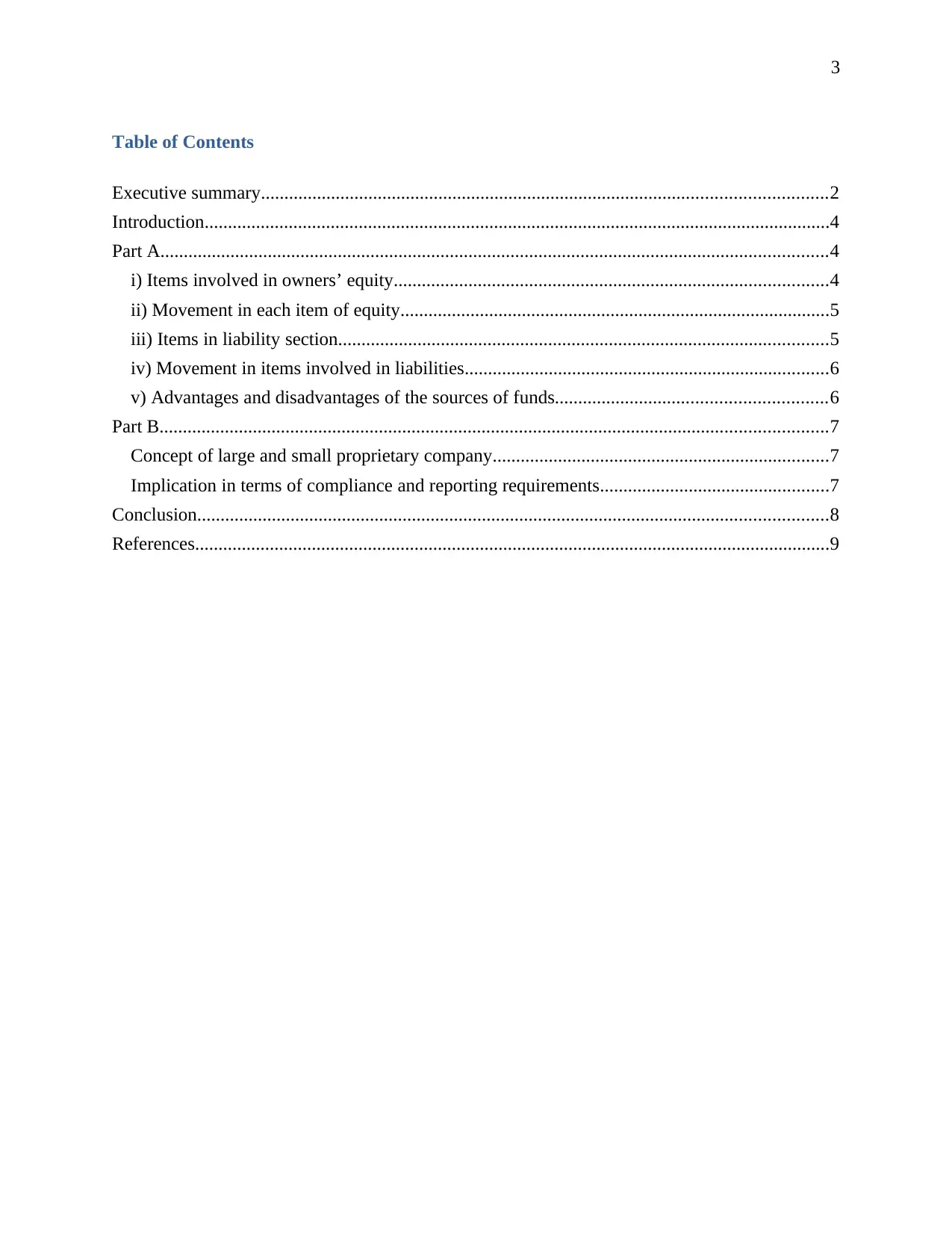
3
Table of Contents
Executive summary.........................................................................................................................2
Introduction......................................................................................................................................4
Part A...............................................................................................................................................4
i) Items involved in owners’ equity.............................................................................................4
ii) Movement in each item of equity............................................................................................5
iii) Items in liability section.........................................................................................................5
iv) Movement in items involved in liabilities..............................................................................6
v) Advantages and disadvantages of the sources of funds..........................................................6
Part B...............................................................................................................................................7
Concept of large and small proprietary company........................................................................7
Implication in terms of compliance and reporting requirements.................................................7
Conclusion.......................................................................................................................................8
References........................................................................................................................................9
Table of Contents
Executive summary.........................................................................................................................2
Introduction......................................................................................................................................4
Part A...............................................................................................................................................4
i) Items involved in owners’ equity.............................................................................................4
ii) Movement in each item of equity............................................................................................5
iii) Items in liability section.........................................................................................................5
iv) Movement in items involved in liabilities..............................................................................6
v) Advantages and disadvantages of the sources of funds..........................................................6
Part B...............................................................................................................................................7
Concept of large and small proprietary company........................................................................7
Implication in terms of compliance and reporting requirements.................................................7
Conclusion.......................................................................................................................................8
References........................................................................................................................................9
⊘ This is a preview!⊘
Do you want full access?
Subscribe today to unlock all pages.

Trusted by 1+ million students worldwide
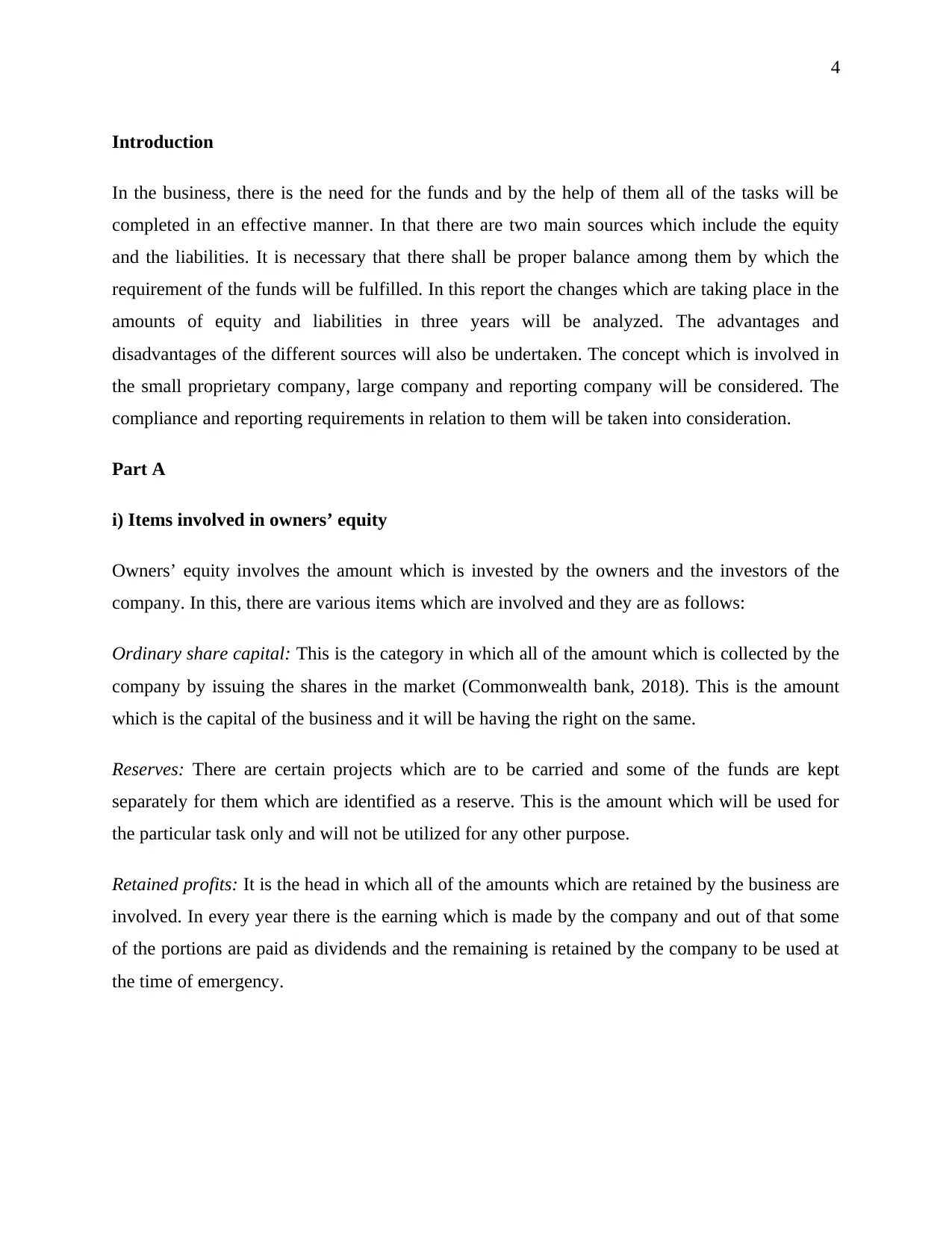
4
Introduction
In the business, there is the need for the funds and by the help of them all of the tasks will be
completed in an effective manner. In that there are two main sources which include the equity
and the liabilities. It is necessary that there shall be proper balance among them by which the
requirement of the funds will be fulfilled. In this report the changes which are taking place in the
amounts of equity and liabilities in three years will be analyzed. The advantages and
disadvantages of the different sources will also be undertaken. The concept which is involved in
the small proprietary company, large company and reporting company will be considered. The
compliance and reporting requirements in relation to them will be taken into consideration.
Part A
i) Items involved in owners’ equity
Owners’ equity involves the amount which is invested by the owners and the investors of the
company. In this, there are various items which are involved and they are as follows:
Ordinary share capital: This is the category in which all of the amount which is collected by the
company by issuing the shares in the market (Commonwealth bank, 2018). This is the amount
which is the capital of the business and it will be having the right on the same.
Reserves: There are certain projects which are to be carried and some of the funds are kept
separately for them which are identified as a reserve. This is the amount which will be used for
the particular task only and will not be utilized for any other purpose.
Retained profits: It is the head in which all of the amounts which are retained by the business are
involved. In every year there is the earning which is made by the company and out of that some
of the portions are paid as dividends and the remaining is retained by the company to be used at
the time of emergency.
Introduction
In the business, there is the need for the funds and by the help of them all of the tasks will be
completed in an effective manner. In that there are two main sources which include the equity
and the liabilities. It is necessary that there shall be proper balance among them by which the
requirement of the funds will be fulfilled. In this report the changes which are taking place in the
amounts of equity and liabilities in three years will be analyzed. The advantages and
disadvantages of the different sources will also be undertaken. The concept which is involved in
the small proprietary company, large company and reporting company will be considered. The
compliance and reporting requirements in relation to them will be taken into consideration.
Part A
i) Items involved in owners’ equity
Owners’ equity involves the amount which is invested by the owners and the investors of the
company. In this, there are various items which are involved and they are as follows:
Ordinary share capital: This is the category in which all of the amount which is collected by the
company by issuing the shares in the market (Commonwealth bank, 2018). This is the amount
which is the capital of the business and it will be having the right on the same.
Reserves: There are certain projects which are to be carried and some of the funds are kept
separately for them which are identified as a reserve. This is the amount which will be used for
the particular task only and will not be utilized for any other purpose.
Retained profits: It is the head in which all of the amounts which are retained by the business are
involved. In every year there is the earning which is made by the company and out of that some
of the portions are paid as dividends and the remaining is retained by the company to be used at
the time of emergency.
Paraphrase This Document
Need a fresh take? Get an instant paraphrase of this document with our AI Paraphraser
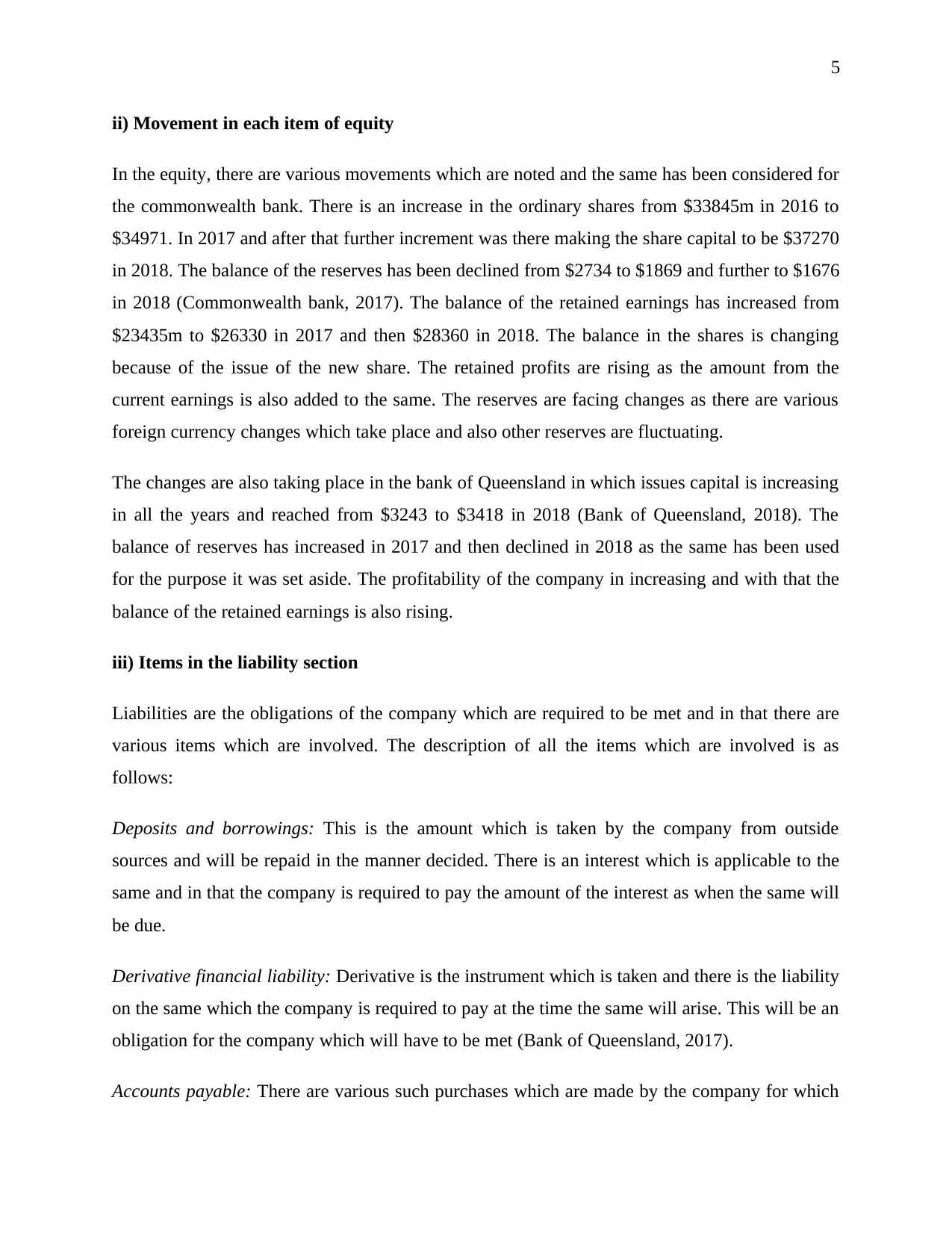
5
ii) Movement in each item of equity
In the equity, there are various movements which are noted and the same has been considered for
the commonwealth bank. There is an increase in the ordinary shares from $33845m in 2016 to
$34971. In 2017 and after that further increment was there making the share capital to be $37270
in 2018. The balance of the reserves has been declined from $2734 to $1869 and further to $1676
in 2018 (Commonwealth bank, 2017). The balance of the retained earnings has increased from
$23435m to $26330 in 2017 and then $28360 in 2018. The balance in the shares is changing
because of the issue of the new share. The retained profits are rising as the amount from the
current earnings is also added to the same. The reserves are facing changes as there are various
foreign currency changes which take place and also other reserves are fluctuating.
The changes are also taking place in the bank of Queensland in which issues capital is increasing
in all the years and reached from $3243 to $3418 in 2018 (Bank of Queensland, 2018). The
balance of reserves has increased in 2017 and then declined in 2018 as the same has been used
for the purpose it was set aside. The profitability of the company in increasing and with that the
balance of the retained earnings is also rising.
iii) Items in the liability section
Liabilities are the obligations of the company which are required to be met and in that there are
various items which are involved. The description of all the items which are involved is as
follows:
Deposits and borrowings: This is the amount which is taken by the company from outside
sources and will be repaid in the manner decided. There is an interest which is applicable to the
same and in that the company is required to pay the amount of the interest as when the same will
be due.
Derivative financial liability: Derivative is the instrument which is taken and there is the liability
on the same which the company is required to pay at the time the same will arise. This will be an
obligation for the company which will have to be met (Bank of Queensland, 2017).
Accounts payable: There are various such purchases which are made by the company for which
ii) Movement in each item of equity
In the equity, there are various movements which are noted and the same has been considered for
the commonwealth bank. There is an increase in the ordinary shares from $33845m in 2016 to
$34971. In 2017 and after that further increment was there making the share capital to be $37270
in 2018. The balance of the reserves has been declined from $2734 to $1869 and further to $1676
in 2018 (Commonwealth bank, 2017). The balance of the retained earnings has increased from
$23435m to $26330 in 2017 and then $28360 in 2018. The balance in the shares is changing
because of the issue of the new share. The retained profits are rising as the amount from the
current earnings is also added to the same. The reserves are facing changes as there are various
foreign currency changes which take place and also other reserves are fluctuating.
The changes are also taking place in the bank of Queensland in which issues capital is increasing
in all the years and reached from $3243 to $3418 in 2018 (Bank of Queensland, 2018). The
balance of reserves has increased in 2017 and then declined in 2018 as the same has been used
for the purpose it was set aside. The profitability of the company in increasing and with that the
balance of the retained earnings is also rising.
iii) Items in the liability section
Liabilities are the obligations of the company which are required to be met and in that there are
various items which are involved. The description of all the items which are involved is as
follows:
Deposits and borrowings: This is the amount which is taken by the company from outside
sources and will be repaid in the manner decided. There is an interest which is applicable to the
same and in that the company is required to pay the amount of the interest as when the same will
be due.
Derivative financial liability: Derivative is the instrument which is taken and there is the liability
on the same which the company is required to pay at the time the same will arise. This will be an
obligation for the company which will have to be met (Bank of Queensland, 2017).
Accounts payable: There are various such purchases which are made by the company for which

6
the payment is not made. In that case, the payment is due and will be required to be paid to the
party at the time which has been set in advance.
Provisions: These are the liabilities which are created on some of the items and assets in which
risk of the receipt is involved. It safeguards the business from sudden losses and will be used at
the time of need.
Tax liability: Every company is required to pay the tax on the income which is made and in that
there is a fixed time at which the payment will be made. Till then the amount is considered as the
liability of the company.
iv) Movement in items involved in liabilities
The total balance of the liabilities is increasing for the bank of Queensland from $47266 in 2016
to $47870 in 2017 and further to $49124 in 2018 (Bank of Queensland, 2018). This is because of
the increase which is made in the number of deposits and borrowing and also the amount payable
to creditors is increasing.
The amount of the liabilities in commonwealth bank is increasing in 2017 from $872437 to
$912658 (Commonwealth bank, 2018). After this, the decline has been made in 2018 and the
amount has reached to $907305. The increase has been made because of the borrowings and
deposits which are taken and then the payments have been made for the borrowings and payables
which decreased the number of total liabilities.
v) Advantages and disadvantages of the sources of funds
In the company, there are major two sources which are used for the funds. They are equity and
borrowings or liabilities. There are several advantages and disadvantages which are present in
relation to them (Alcock, Finn and Tan, 2012). The equity is beneficial as that is the fund of the
company and there will be no liability which will be arising on the same. The amount will be
free of cost and no additional charges are to be incurred but this can be raised in a limited
amount which is the demerit of the same.
The borrowings are made by the company and it is possible to raise the required amount with the
help of borrowings and deposits. They will be able to provide the required amount of the funds
the payment is not made. In that case, the payment is due and will be required to be paid to the
party at the time which has been set in advance.
Provisions: These are the liabilities which are created on some of the items and assets in which
risk of the receipt is involved. It safeguards the business from sudden losses and will be used at
the time of need.
Tax liability: Every company is required to pay the tax on the income which is made and in that
there is a fixed time at which the payment will be made. Till then the amount is considered as the
liability of the company.
iv) Movement in items involved in liabilities
The total balance of the liabilities is increasing for the bank of Queensland from $47266 in 2016
to $47870 in 2017 and further to $49124 in 2018 (Bank of Queensland, 2018). This is because of
the increase which is made in the number of deposits and borrowing and also the amount payable
to creditors is increasing.
The amount of the liabilities in commonwealth bank is increasing in 2017 from $872437 to
$912658 (Commonwealth bank, 2018). After this, the decline has been made in 2018 and the
amount has reached to $907305. The increase has been made because of the borrowings and
deposits which are taken and then the payments have been made for the borrowings and payables
which decreased the number of total liabilities.
v) Advantages and disadvantages of the sources of funds
In the company, there are major two sources which are used for the funds. They are equity and
borrowings or liabilities. There are several advantages and disadvantages which are present in
relation to them (Alcock, Finn and Tan, 2012). The equity is beneficial as that is the fund of the
company and there will be no liability which will be arising on the same. The amount will be
free of cost and no additional charges are to be incurred but this can be raised in a limited
amount which is the demerit of the same.
The borrowings are made by the company and it is possible to raise the required amount with the
help of borrowings and deposits. They will be able to provide the required amount of the funds
⊘ This is a preview!⊘
Do you want full access?
Subscribe today to unlock all pages.

Trusted by 1+ million students worldwide
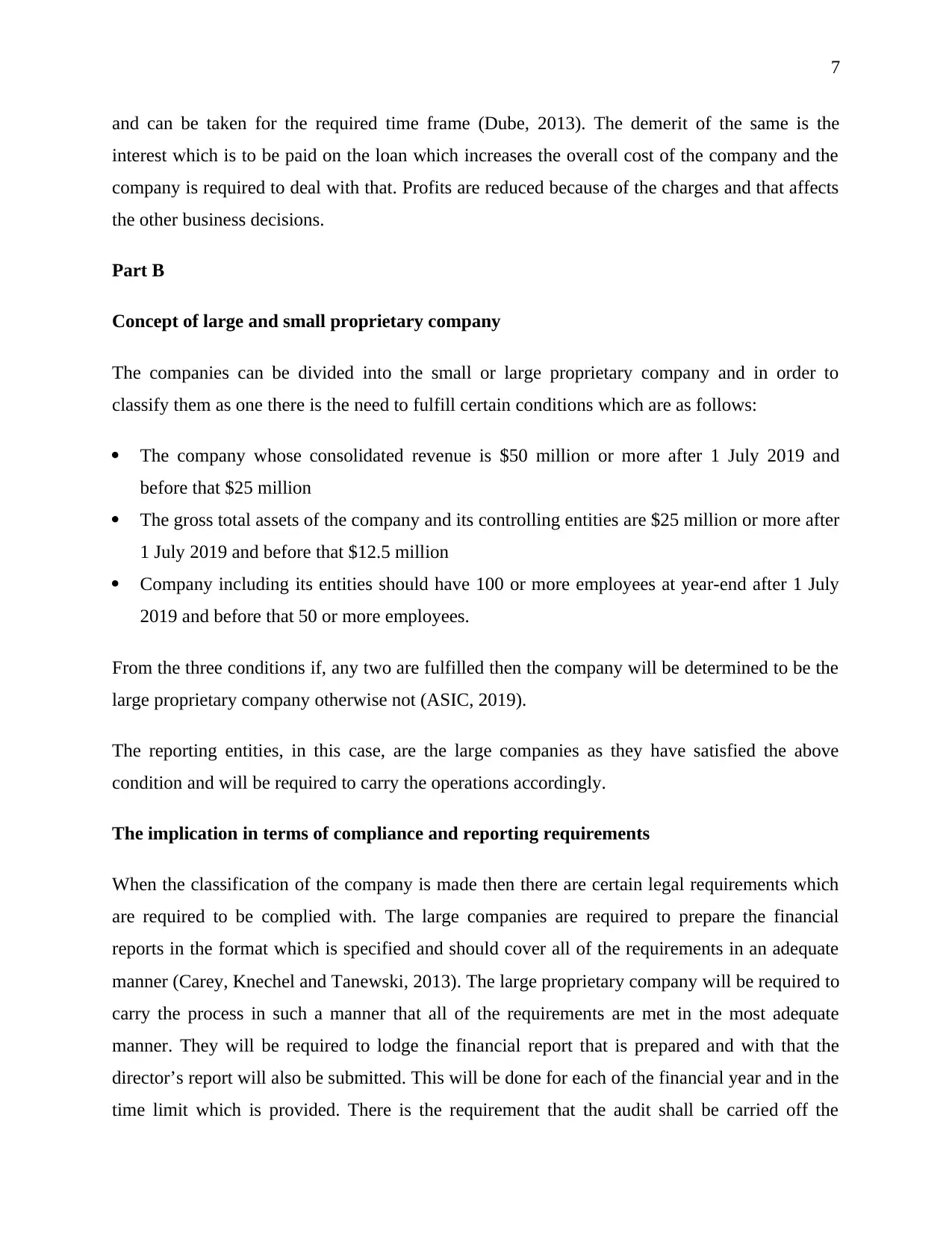
7
and can be taken for the required time frame (Dube, 2013). The demerit of the same is the
interest which is to be paid on the loan which increases the overall cost of the company and the
company is required to deal with that. Profits are reduced because of the charges and that affects
the other business decisions.
Part B
Concept of large and small proprietary company
The companies can be divided into the small or large proprietary company and in order to
classify them as one there is the need to fulfill certain conditions which are as follows:
The company whose consolidated revenue is $50 million or more after 1 July 2019 and
before that $25 million
The gross total assets of the company and its controlling entities are $25 million or more after
1 July 2019 and before that $12.5 million
Company including its entities should have 100 or more employees at year-end after 1 July
2019 and before that 50 or more employees.
From the three conditions if, any two are fulfilled then the company will be determined to be the
large proprietary company otherwise not (ASIC, 2019).
The reporting entities, in this case, are the large companies as they have satisfied the above
condition and will be required to carry the operations accordingly.
The implication in terms of compliance and reporting requirements
When the classification of the company is made then there are certain legal requirements which
are required to be complied with. The large companies are required to prepare the financial
reports in the format which is specified and should cover all of the requirements in an adequate
manner (Carey, Knechel and Tanewski, 2013). The large proprietary company will be required to
carry the process in such a manner that all of the requirements are met in the most adequate
manner. They will be required to lodge the financial report that is prepared and with that the
director’s report will also be submitted. This will be done for each of the financial year and in the
time limit which is provided. There is the requirement that the audit shall be carried off the
and can be taken for the required time frame (Dube, 2013). The demerit of the same is the
interest which is to be paid on the loan which increases the overall cost of the company and the
company is required to deal with that. Profits are reduced because of the charges and that affects
the other business decisions.
Part B
Concept of large and small proprietary company
The companies can be divided into the small or large proprietary company and in order to
classify them as one there is the need to fulfill certain conditions which are as follows:
The company whose consolidated revenue is $50 million or more after 1 July 2019 and
before that $25 million
The gross total assets of the company and its controlling entities are $25 million or more after
1 July 2019 and before that $12.5 million
Company including its entities should have 100 or more employees at year-end after 1 July
2019 and before that 50 or more employees.
From the three conditions if, any two are fulfilled then the company will be determined to be the
large proprietary company otherwise not (ASIC, 2019).
The reporting entities, in this case, are the large companies as they have satisfied the above
condition and will be required to carry the operations accordingly.
The implication in terms of compliance and reporting requirements
When the classification of the company is made then there are certain legal requirements which
are required to be complied with. The large companies are required to prepare the financial
reports in the format which is specified and should cover all of the requirements in an adequate
manner (Carey, Knechel and Tanewski, 2013). The large proprietary company will be required to
carry the process in such a manner that all of the requirements are met in the most adequate
manner. They will be required to lodge the financial report that is prepared and with that the
director’s report will also be submitted. This will be done for each of the financial year and in the
time limit which is provided. There is the requirement that the audit shall be carried off the
Paraphrase This Document
Need a fresh take? Get an instant paraphrase of this document with our AI Paraphraser

8
accounts which have been prepared. This is required to be prepared in all the cases unless the
relief has been provided by the ASIC.
All of these are the requirements which are requirements which will have to be complied by the
large company in a compulsory manner (Fu, Carson and Simnett, 2015). All of them can also be
fulfilled by the small proprietary company but the same is not compulsory for them and they may
carry the same if they wish to.
Conclusion
In the report, all of the sources which have been used by both the companies for the collection of
the funds have been identified. In that there is the determination of the items which are involved
in the equity as well as the liabilities. A complete understanding is obtained and with that the
changes that have taken place in them in the last three years have also been identified. There is
the change which is taking place and with that the reason which is responsible for the undertaken
change has also been undertaken. The companies are classified in the large and small proprietary
company and for that there are several conditions which are required to be fulfilled. All of them
have been identified and conditions have also been taken into account. The companies have been
classified according to the same as the large proprietary companies and they will be required to
carry the process accordingly. There are several requirements which are to be fulfilled and all of
them have been identified according to the law which is to be fulfilled.
accounts which have been prepared. This is required to be prepared in all the cases unless the
relief has been provided by the ASIC.
All of these are the requirements which are requirements which will have to be complied by the
large company in a compulsory manner (Fu, Carson and Simnett, 2015). All of them can also be
fulfilled by the small proprietary company but the same is not compulsory for them and they may
carry the same if they wish to.
Conclusion
In the report, all of the sources which have been used by both the companies for the collection of
the funds have been identified. In that there is the determination of the items which are involved
in the equity as well as the liabilities. A complete understanding is obtained and with that the
changes that have taken place in them in the last three years have also been identified. There is
the change which is taking place and with that the reason which is responsible for the undertaken
change has also been undertaken. The companies are classified in the large and small proprietary
company and for that there are several conditions which are required to be fulfilled. All of them
have been identified and conditions have also been taken into account. The companies have been
classified according to the same as the large proprietary companies and they will be required to
carry the process accordingly. There are several requirements which are to be fulfilled and all of
them have been identified according to the law which is to be fulfilled.

9
References
Alcock, J., Finn, F., and Tan, K.J.K. (2012) The determinants of debt maturity in Australian
firms. Accounting & Finance, 52(2), pp.313-341.
ASIC. (2019) Are you a large or small proprietary company. [Online] Available at:
https://asic.gov.au/regulatory-resources/financial-reporting-and-audit/preparers-of-financial-
reports/are-you-a-large-or-small-proprietary-company/ [Accessed 20 September 2019]
Bank of Queensland. (2017) annual report. [Online] Available at:
https://www.boq.com.au/content/dam/boq/files/reports/annual-report/annual-report-2017.pdf
[Accessed 20 September 2019]
Bank of Queensland. (2018) annual report. [Online] Available at:
https://www.boq.com.au/content/dam/boq/files/shareholder-centre/financial-results/2018/
FY2018_Annual_Report.pdf [Accessed 20 September 2019]
Carey, P., Knechel, W.R. and Tanewski, G. (2013) Costs and benefits of mandatory auditing of
for‐profit private and not‐for‐profit companies in Australia. Australian Accounting
Review, 23(1), pp.43-53.
Commonwealth bank. (2017) annual report. [Online] Available at:
https://www.commbank.com.au/content/dam/commbank/about-us/shareholders/pdfs/annual-
reports/annual_report_2017_14_aug_2017.pdf [Accessed 20 September 2019]
Commonwealth bank. (2018) annual report. [Online] Available at:
https://www.commbank.com.au/content/dam/commbank/about-us/shareholders/pdfs/results/
fy18/cba-annual-report-2018.pdf [Accessed 20 September 2019]
Dube, H. (2013) The impact of debt financing on productivity of small and medium scale
enterprises (SMEs): A case study of SMEs in Masvingo urban. International Journal of
Economics, Business and Finance, 1(10), pp.371-381.
Fu, Y., Carson, E. and Simnett, R. (2015) Transparency report disclosure by Australian audit
References
Alcock, J., Finn, F., and Tan, K.J.K. (2012) The determinants of debt maturity in Australian
firms. Accounting & Finance, 52(2), pp.313-341.
ASIC. (2019) Are you a large or small proprietary company. [Online] Available at:
https://asic.gov.au/regulatory-resources/financial-reporting-and-audit/preparers-of-financial-
reports/are-you-a-large-or-small-proprietary-company/ [Accessed 20 September 2019]
Bank of Queensland. (2017) annual report. [Online] Available at:
https://www.boq.com.au/content/dam/boq/files/reports/annual-report/annual-report-2017.pdf
[Accessed 20 September 2019]
Bank of Queensland. (2018) annual report. [Online] Available at:
https://www.boq.com.au/content/dam/boq/files/shareholder-centre/financial-results/2018/
FY2018_Annual_Report.pdf [Accessed 20 September 2019]
Carey, P., Knechel, W.R. and Tanewski, G. (2013) Costs and benefits of mandatory auditing of
for‐profit private and not‐for‐profit companies in Australia. Australian Accounting
Review, 23(1), pp.43-53.
Commonwealth bank. (2017) annual report. [Online] Available at:
https://www.commbank.com.au/content/dam/commbank/about-us/shareholders/pdfs/annual-
reports/annual_report_2017_14_aug_2017.pdf [Accessed 20 September 2019]
Commonwealth bank. (2018) annual report. [Online] Available at:
https://www.commbank.com.au/content/dam/commbank/about-us/shareholders/pdfs/results/
fy18/cba-annual-report-2018.pdf [Accessed 20 September 2019]
Dube, H. (2013) The impact of debt financing on productivity of small and medium scale
enterprises (SMEs): A case study of SMEs in Masvingo urban. International Journal of
Economics, Business and Finance, 1(10), pp.371-381.
Fu, Y., Carson, E. and Simnett, R. (2015) Transparency report disclosure by Australian audit
⊘ This is a preview!⊘
Do you want full access?
Subscribe today to unlock all pages.

Trusted by 1+ million students worldwide
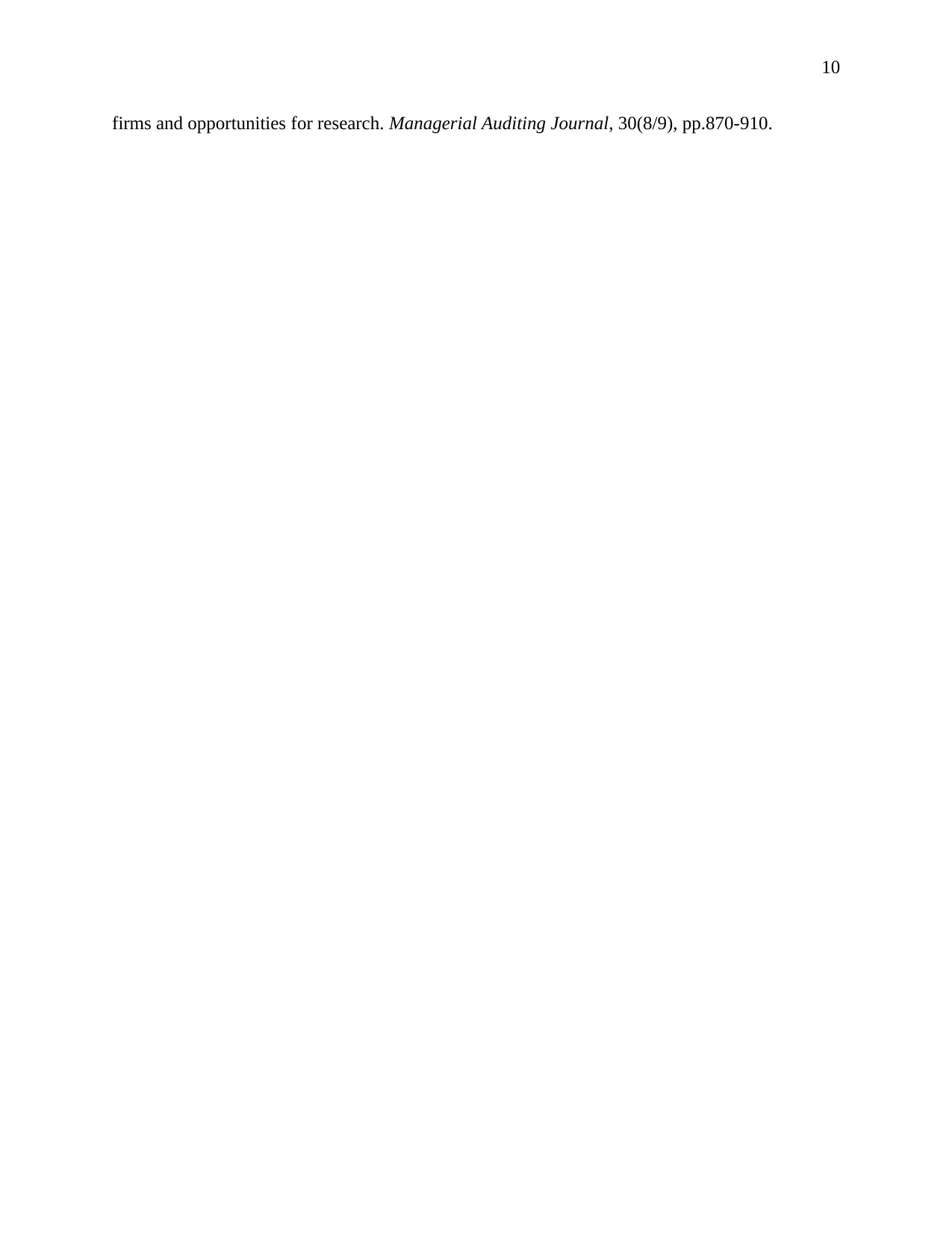
10
firms and opportunities for research. Managerial Auditing Journal, 30(8/9), pp.870-910.
firms and opportunities for research. Managerial Auditing Journal, 30(8/9), pp.870-910.
1 out of 10
Related Documents
Your All-in-One AI-Powered Toolkit for Academic Success.
+13062052269
info@desklib.com
Available 24*7 on WhatsApp / Email
![[object Object]](/_next/static/media/star-bottom.7253800d.svg)
Unlock your academic potential
Copyright © 2020–2025 A2Z Services. All Rights Reserved. Developed and managed by ZUCOL.





